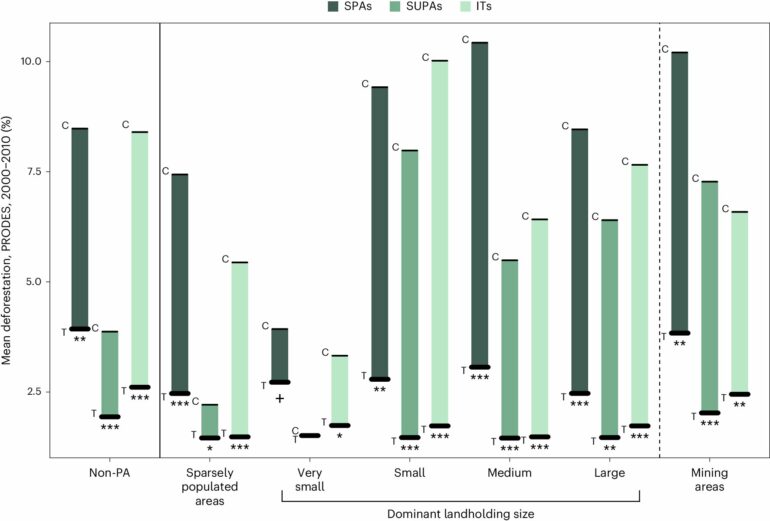A new analysis shows that land protection initiatives in the Brazilian Legal Amazon (BLA) reduced deforestation by up to 83% between 2000 and 2010. Such impressive results highlight the vital role of land protection policies in achieving ambitious goals, including the UN biodiversity target to protect 30% of the planet’s surface by 2030.
Reversing biodiversity loss in the Amazon while combating climate change is recognized by Brazil and the international community as a key priority, but more ambitious solutions are required in coming years. Although deforestation rates in the Brazilian Amazon have recently declined, the region still lost 5,000 square kilometers of rainforest in 2023—equivalent to three times the size of greater London.
Yet the research, published in Nature Ecology & Evolution, highlights that for Indigenous communities in the Amazon, land protection may come with hidden socio-economic costs. The study revealed that incomes in Indigenous Territories were up to 36% lower compared to other land uses, shining a light on the trade-offs decisionmakers must navigate when establishing and expanding forest conservation projects.
Researchers from the UK, Brazil, Sweden and the U.S. looked at three types of protection arrangements to uncover such trade-offs—Indigenous Territories (ITs) that return ancestral land and resources to Indigenous peoples, strict protected areas (SPAs) that protected from everything apart from light human disturbance, and sustainable use protected areas (SUPAs) that allow sustainable use of natural resources while protecting the area from widescale industrial production.
By comparing both environmental and socioeconomic outcomes across protected and unprotected areas, used for agriculture and mining, the analysis provides a more holistic analysis of policy impacts on both people and the environment.
Indigenous people are the most disadvantaged group in Brazil, with 33% living below the poverty line. As the researchers emphasize in a research briefing based on the study, we must not leave Indigenous peoples behind due to a lack of social protection or alternative support programs.
Efforts to secure land rights must be accompanied by additional initiatives to ensure these communities are not socioeconomically disadvantaged, such as removing access barriers to existing social protection programs and other forms of support.
Dr. Johan Oldekop, at The University of Manchester’s Global Development Institute, said, “Our research demonstrates that rights to land and resources for Indigenous people are necessary but perhaps insufficient mechanisms to bridge conservation and development.
“In highlighting this problem, we hope to improve current understandings of how conservation and development trade off against each other according to different land use management decisions, including different forms of protected areas.”
Recent scholarship asserts that ITs can prevent deforestation and other ecologically destructive practices. However, as lead author Dr. Bowy den Braber explains, “Carefully weighing up the benefits and drawbacks of different land use options can help policymakers maximize progress towards both conservation and development goals.”
Co-author Dr. Marina Schmoeller, who recently completed her Ph.D. at the Federal University of Rio de Janeiro, said, “We highlight the importance of Indigenous territories for protecting biodiversity, which is timely considering the ongoing debates in the Brazilian Supreme Court that could potentially limit Indigenous people’s claim for lands not only in the Amazon, but in the whole of the country.”
Dr. Karl Evans, University of Sheffield, remarked, “Protected areas and Indigenous Territories are highly effective at reducing deforestation in the Amazon. Protecting forests does more to support local people’s livelihoods and well-being than opening them up to large agri-business and mining, while also addressing the climate and biodiversity emergencies.”
More information:
Bowy den Braber et al, Socio-economic and environmental trade-offs in Amazonian protected areas and Indigenous territories revealed by assessing competing land uses, Nature Ecology & Evolution (2024). DOI: 10.1038/s41559-024-02458-w
Provided by
University of Manchester
Citation:
Land protection initiatives reduced Amazon deforestation by up to 83%, new analysis finds (2024, July 15)



